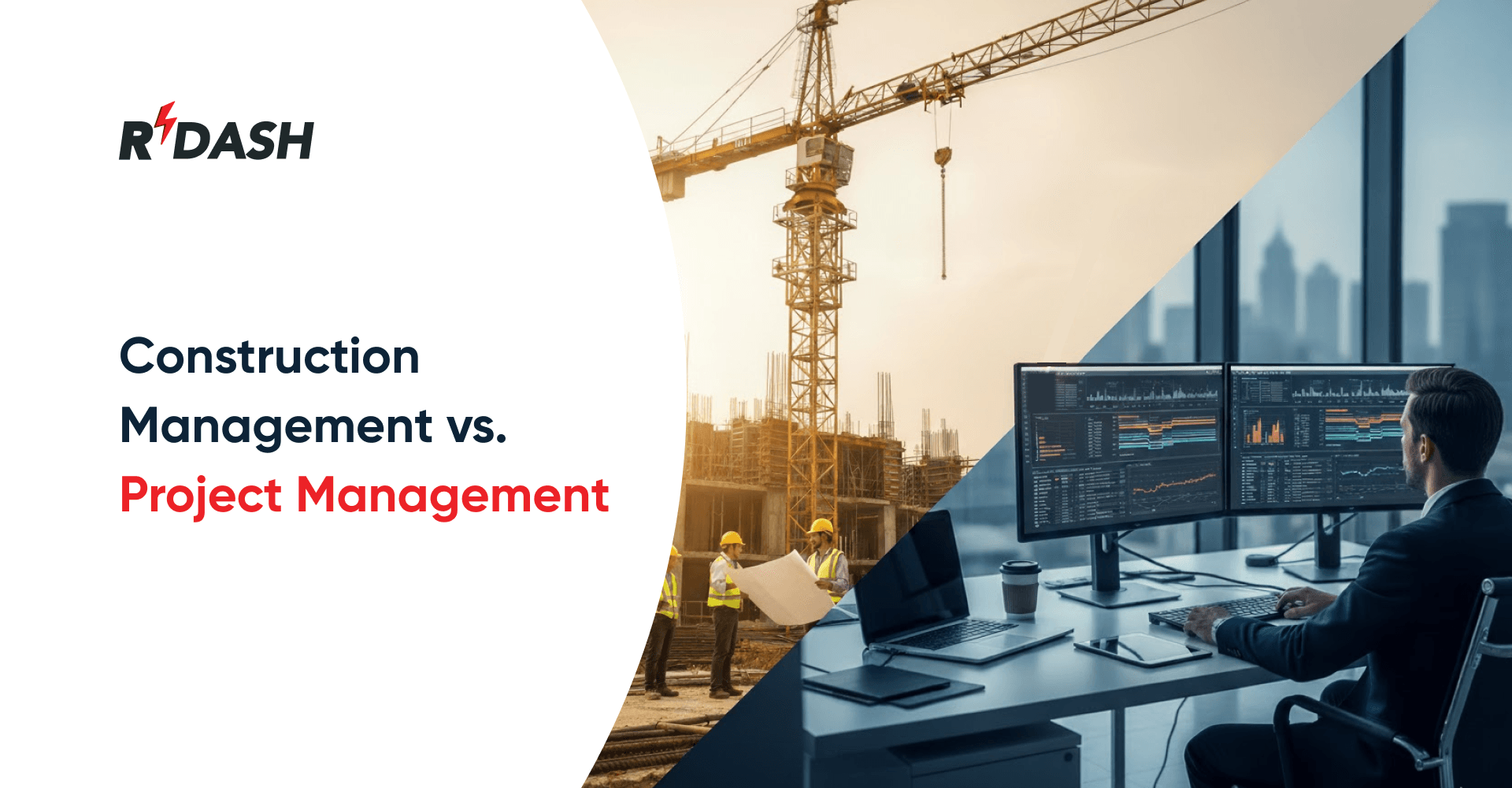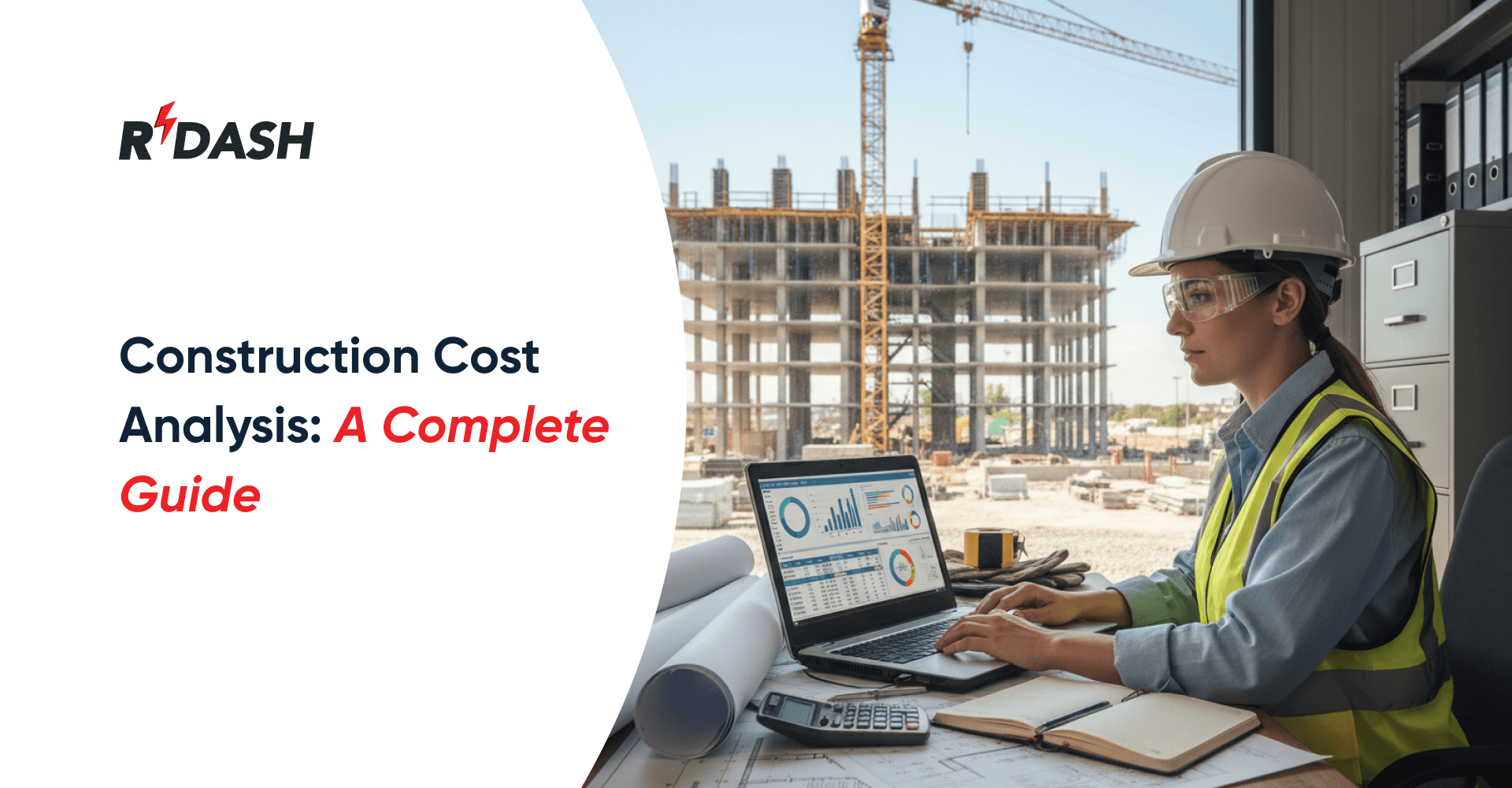Earned Value Management (EVM) is a project management technique that integrates scope, schedule, and cost variables to assess project performance and progress comprehensively. In today’s dynamic construction landscape, managing projects efficiently is more critical than ever, and EVM has emerged as a powerful methodology to ensure successful project outcomes. It provides construction managers and stakeholders with an accurate picture of the project status, enabling proactive decision-making and effective control over project variables. By offering a detailed view of project performance, EVM allows for early identification of potential issues, such as cost overruns or schedule delays, and supports timely corrective actions to keep the project on track.

This blog explores the principles of Earned Value Management (EVM), its importance in construction, its applicability to the Indian construction industry, and real-life examples to illustrate its benefits.
Understanding Earned Value Management (EVM)
Earned Value Management (EVM) is a project management technique that allows for the integrated assessment of project performance by comparing planned work against actual work completed and the costs incurred. It provides an early warning system for project delays and cost overruns by highlighting variances in schedule and cost performance.

Core Components of Earned Value Management
- Planned Value (PV): Also known as Budgeted Cost of Work Scheduled (BCWS), PV represents the value of work planned to be completed by a specific date. It reflects the cost baseline or budgeted amount of work planned as of the reporting date.
- Earned Value (EV): Also referred to as Budgeted Cost of Work Performed (BCWP), EV represents the value of the actual work completed to date. It is calculated by multiplying the percentage of completed work by the project budget.
- Actual Cost (AC): Also known as Actual Cost of Work Performed (ACWP), AC represents the actual costs incurred for the work completed by a specific date.
Key Performance Indicators (KPIs) in Earned Value Management

- Cost Variance (CV): CV is the difference between the earned value and the actual cost. It indicates whether the project is under or over budget.
CV=EV−AC
- Schedule Variance (SV): SV is the difference between the earned value and the planned value. It indicates whether the project is ahead of or behind schedule.
SV=EV−PV - Cost Performance Index (CPI): CPI is a measure of cost efficiency, calculated by dividing earned value by actual cost.
CPI=EV/AC
- Schedule Performance Index (SPI): SPI is a measure of schedule efficiency, calculated by dividing earned value by planned value.
SPI=EV/PV - Estimate at Completion (EAC): EAC predicts the total cost of the project upon completion, considering current project performance.
EAC=BAC/CPI - Estimate to Complete (ETC): ETC estimates the cost required to complete the remaining project work.
ETC=EAC−AC - Variance at Completion (VAC): VAC predicts the cost variance at the end of the project.
VAC=BAC−EAC
Importance of Earned Value Management in Construction Projects
In construction, where projects are complex and multi-faceted, Earned Value Management provides a structured approach to project control. Here’s why EVM is crucial:
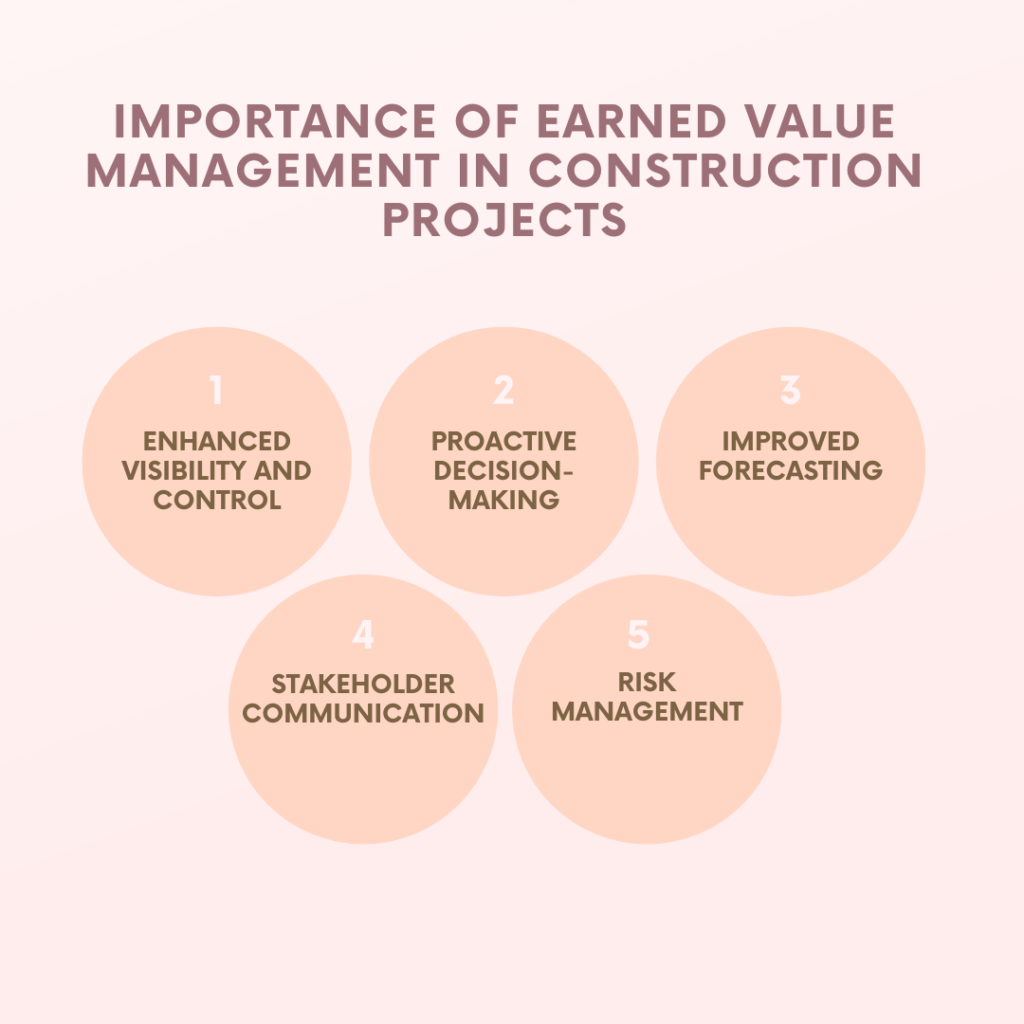
- Enhanced Visibility and Control: Earned Value Management offers a clear snapshot of project performance against the baseline, allowing for real-time monitoring and control of cost and schedule.
- Proactive Decision-Making: By providing early warning signs of potential delays and cost overruns, Earned Value Management enables project managers to take corrective actions before issues escalate.
- Improved Forecasting: Earned Value Management helps in accurately forecasting project outcomes, allowing for better resource allocation and budget management.
- Stakeholder Communication: Earned Value Management provides standardized metrics that facilitate transparent communication with stakeholders, enhancing trust and accountability.
- Risk Management: Earned Value Management aids in identifying and managing risks by highlighting variances from the plan, allowing for prompt risk mitigation strategies.
Earned Value Management in the Indian Construction Industry
The Indian construction industry, characterized by rapid urbanization, complex infrastructure projects, and evolving regulatory frameworks, presents unique challenges. EVM can address several critical issues faced by the industry:

- Cost Overruns: Indian construction projects often face cost overruns due to poor planning, unexpected material costs, and inefficient resource utilization. EVM helps monitor costs and take corrective actions in real time.
- Schedule Delays: Delays are common in Indian construction projects due to factors like land acquisition issues, regulatory approvals, and labor strikes. EVM’s schedule variance analysis helps identify delays early, enabling timely interventions.
- Resource Allocation: Effective resource allocation is crucial in the Indian context, where projects often suffer from resource shortages. EVM assists in forecasting resource requirements and optimizing resource usage.
- Compliance and Reporting: With increasing regulatory scrutiny in India, EVM provides a robust framework for compliance with project reporting requirements, ensuring transparency and accountability.
- Project Complexity: The complexity of Indian construction projects, from mega infrastructure developments to residential projects, requires meticulous management. EVM offers a structured approach to managing such complexities, ensuring successful project outcomes.
Applying Earned Value Management in Indian Construction Projects: Real-Life Examples

1. Metro Rail Projects
Metro rail projects in India, such as the Delhi Metro and Mumbai Metro, are complex and involve multiple stakeholders, significant investments, and tight schedules. Implementing EVM has helped these projects maintain budgetary control and adhere to schedules. For instance, in the Delhi Metro project, EVM was used to monitor project progress and cost, leading to successful phase completions with minimal delays and cost overruns.
2. Smart City Initiatives
India’s Smart City initiatives aim to develop sustainable urban infrastructure across various cities. EVM is applied to manage multiple parallel projects, such as road construction, waste management systems, and water supply networks, ensuring that these projects are completed within budget and on time. The use of EVM in projects like the Pune Smart City and Bhubaneswar Smart City has led to more effective resource allocation and better financial management.
3. Highways and Expressways
India’s ambitious highway projects, like the Delhi-Mumbai Expressway, require meticulous planning and execution. EVM has been instrumental in these projects by providing early warning signs of delays and cost escalations, enabling timely corrective actions. For example, the use of EVM in the construction of the Eastern Peripheral Expressway around Delhi helped the project stay within budget and complete ahead of schedule, despite the challenges posed by land acquisition issues and environmental concerns.
Implementing Earned Value Management in Construction Projects: Best Practices
To effectively implement EVM in construction projects, especially in the Indian context, consider the following best practices:

- Establish a Strong Baseline: A well-defined baseline is critical for effective EVM implementation. Ensure that the scope, schedule, and cost baselines are realistic and agreed upon by all stakeholders.
- Train Project Teams: EVM requires a thorough understanding of its concepts and metrics. Provide comprehensive training to project teams and stakeholders to ensure effective adoption.
- Integrate with Project Management Tools: Use project management software that supports EVM to streamline data collection and analysis. Integrating EVM with tools like Microsoft Project, Primavera, or specialized EVM software can enhance accuracy and efficiency.
- Regular Monitoring and Reporting: Establish a routine for regular monitoring and reporting of EVM metrics. This helps in identifying variances early and taking corrective actions promptly.
- Engage Stakeholders: Involve all stakeholders in the EVM process, including contractors, suppliers, and clients. Regularly communicate EVM findings to stakeholders to maintain transparency and build trust.
- Customize for Local Context: Adapt EVM practices to suit the local context of Indian construction projects, considering factors such as regulatory requirements, cultural nuances, and market conditions.
Challenges of Implementing Earned Value Management in Indian Construction Projects
While EVM offers significant benefits, its implementation in the Indian construction industry faces several challenges:
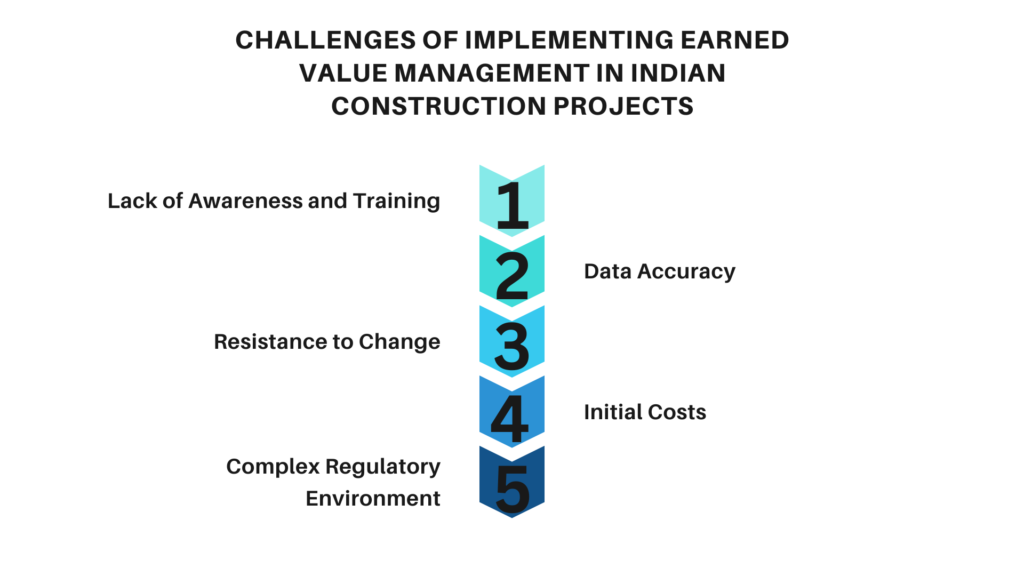
- Lack of Awareness and Training: Many construction professionals in India lack awareness and training in EVM, hindering its adoption.
- Data Accuracy: EVM relies on accurate and timely data. However, data collection processes in Indian construction projects are often inconsistent, affecting the accuracy of EVM metrics.
- Resistance to Change: Traditional project management practices are deeply entrenched in the Indian construction industry, leading to resistance to adopting new methodologies like EVM.
- Initial Costs: Implementing EVM requires investment in training, software, and process changes, which can be a deterrent for some construction companies, particularly smaller firms.
- Complex Regulatory Environment: Navigating India’s complex regulatory landscape can complicate EVM implementation, especially for projects requiring multiple approvals and clearances.
Overcoming Challenges: Strategies for Successful Earned Value Management Adoption
To overcome these challenges and successfully implement EVM in Indian construction projects, consider the following strategies:
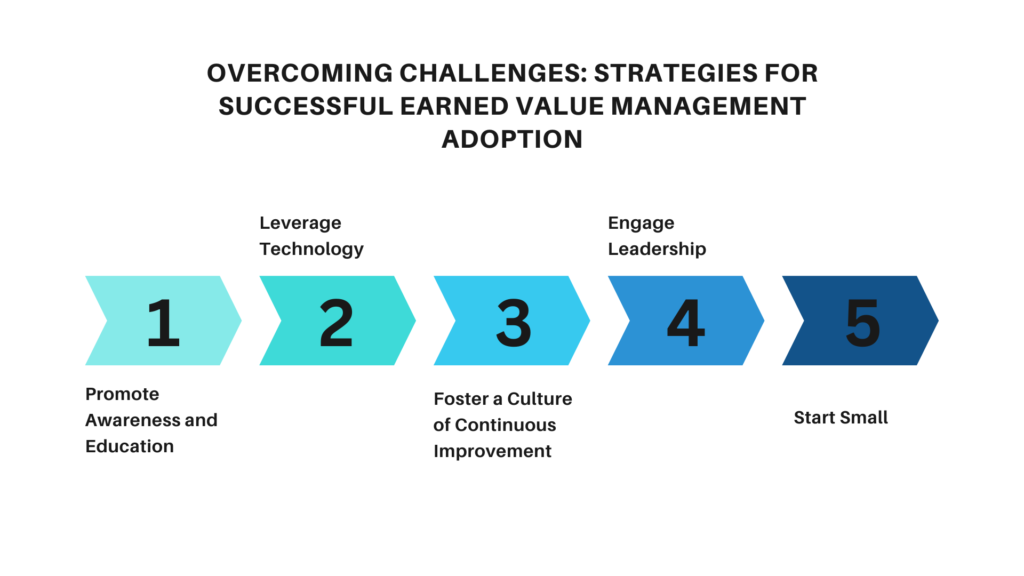
- Promote Awareness and Education: Conduct workshops, seminars, and training programs to raise awareness about the benefits of EVM and provide hands-on training to project teams.
- Leverage Technology: Use technology to streamline data collection and reporting processes, ensuring accurate and timely data for EVM analysis.
- Foster a Culture of Continuous Improvement: Encourage a culture of continuous improvement within the organization, where EVM is seen as a tool for enhancing project performance rather than just another compliance requirement.
- Engage Leadership: Secure buy-in from senior management and project stakeholders to drive EVM adoption and overcome resistance to change.
- Start Small: Begin with pilot projects to demonstrate the effectiveness of EVM, build confidence among project teams, and gradually scale up to larger projects.
Key Features of RDash for Enhanced Earned Value Management (EVM) in Construction Projects
To further enhance the efficiency of EVM and provide a more holistic approach to project management in the construction industry, our app RDash offers the following key features:

Recce (Site Surveys):
- Detailed Site Analysis: RDash enables a comprehensive reconnaissance survey (recce) to understand the site conditions before starting any construction activities.
- Data Collection and Reporting: The app facilitates the collection of crucial data such as topography, existing structures, and environmental conditions, which are then compiled into detailed reports.
- Guideline Development: By capturing site conditions accurately, RDash helps in developing guidelines for material movement, storage areas, work shift timings, and structural layouts.
Design Phase Management:
- Centralized Design Repositories: RDash provides a centralized platform for managing all design documents and drawings, ensuring that the latest versions are always accessible to the team.
- Collaboration Tools: The app includes features that allow architects, engineers, and project managers to collaborate in real-time, reducing the risk of miscommunication and design errors.
- Design Review and Approval: With built-in workflows for design review and approval, RDash streamlines the process, helping to avoid delays that could impact the project schedule.
BOQ (Bill of Quantities) Preparation and Management:
- Automated BOQ Generation: RDash automates the generation of BOQs, reducing manual errors and saving time. It provides a detailed breakdown of materials, labor, and costs required for the project.
- Cost Estimation and Tracking: The app offers tools for accurate cost estimation and tracking, helping to ensure that the project remains within budget.
- Version Control: Any changes to the BOQ are tracked, ensuring transparency and accountability in managing project finances.
Order Management:
- Integrated Procurement Processes: RDash integrates the procurement process, allowing project managers to create and manage purchase orders directly within the app.
- Supplier Management: The app maintains a database of suppliers, facilitating easy comparison of rates and terms, and ensuring the best deals for materials and services.
- Order Tracking: It allows for real-time tracking of orders, ensuring that materials arrive on site as needed, preventing delays due to material shortages.
Work Progress Tracking:
- Real-Time Progress Updates: RDash enables real-time tracking of work progress against the project schedule, providing an accurate picture of the current status.
- Visual Dashboards: The app features visual dashboards that display key performance indicators (KPIs), making it easy to monitor progress and identify potential issues early.
- Daily Reporting: With features for daily reporting, project managers can quickly assess progress, resource utilization, and any deviations from the plan.
Snag Management:
- Snag Identification and Logging: RDash provides tools for identifying and logging snags (defects) that occur during construction, ensuring they are documented and addressed promptly.
- Defect Resolution Tracking: The app allows for tracking the status of defect resolution, ensuring accountability and timely correction of issues to maintain project quality.
- Quality Assurance Reports: It generates quality assurance reports that help in maintaining high standards throughout the construction process.
Financial Closure:
- Comprehensive Financial Tracking: RDash tracks all financial transactions related to the project, from initial estimates to final payments, providing a clear view of the project’s financial health.
- Cost Reconciliation: The app helps in reconciling costs against the budget, identifying any variances, and ensuring that the project stays financially viable.
- Automated Invoicing and Payments: It streamlines the invoicing and payment process, reducing administrative burden and ensuring timely financial closure.
Project Manager (PM) Task List:
- Task Assignment and Monitoring: RDash allows project managers to assign tasks to team members and monitor their progress in real-time.
- Prioritization and Deadline Management: The app helps in prioritizing tasks and managing deadlines effectively, ensuring that all critical activities are completed on schedule.
- Performance Analytics: It provides insights into team performance, helping managers to make data-driven decisions to optimize productivity.
Incorporating Earned Value Management (EVM) into construction projects can significantly improve project performance by providing a clear picture of progress and facilitating proactive management. With tools like RDash, construction companies can take EVM to the next level, integrating it seamlessly with other critical project management functions such as site surveys, design management, BOQ preparation, order management, work progress tracking, snag management, financial closure, and task management. This holistic approach ensures that construction projects are completed on time, within budget, and to the highest quality standards, positioning Indian construction companies for success in a competitive market.
Conclusion
Earned Value Management (EVM) is a powerful project management tool that offers significant benefits for construction projects, particularly in a complex and dynamic environment like India. By providing a comprehensive view of project performance, EVM enables proactive decision-making, improved forecasting, and effective stakeholder communication. However, successful EVM implementation requires overcoming challenges related to awareness, data accuracy, resistance to change, and initial costs. With the right strategies, Indian construction companies can harness the power of EVM to drive project success and achieve better outcomes.
By integrating EVM into their project management practices, Indian construction companies can not only enhance project performance but also build a competitive edge in an increasingly demanding market. Whether it’s a metro rail project, a smart city initiative, or a highway development, EVM provides the tools needed to navigate the complexities of construction projects and deliver value to stakeholders.



